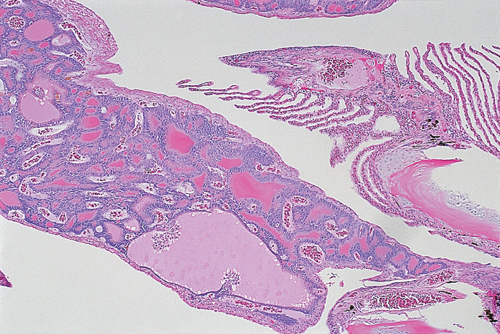Difference between revisions of "Ornamental Fish Q&A 08"
| Line 1: | Line 1: | ||
| + | {{Manson | ||
| + | |book = Ornamental Fish Q&A}} | ||
| + | |||
[[File:Ornamental Fish 08.jpg|centre|500px]] | [[File:Ornamental Fish 08.jpg|centre|500px]] | ||
Latest revision as of 22:28, 30 October 2011
| This question was provided by Manson Publishing as part of the OVAL Project. See more Ornamental Fish Q&A. |
A slippery dick from a large marine exhibit aquarium is selected at random for routine health screening. A large bilateral nodular swelling at the base of the gills and extending upward along the lower gill arches is found. A histologic section is shown.
| Question | Answer | Article | |
| What is your diagnosis? | Thyroid hyperplasia (goiter). Eosinophilic colloid fills thyroid follicles of varying size and shape. Secondary lamellae of the gill are present at upper right. The thyroid of most fish is a diffuse organ located along the floor of the gill chamber, but thyroid tissue can also be found in the spleen, heart, and cranial kidney. Goiter may be difficult to distinguish from thyroid carcinoma, and was mistakenly described as such when initially found in salmonids on iodine-deficient diets. |
Link to Article | |
| What are some treatment options? | Iodine-deficiency goiter responds to iodine-replacement therapy. A primary iodine deficiency is unlikely in marine fish. Search for and eliminate goitrogenic substances in feed. A similar syndrome in sharks responds to thyroxine therapy, presumably by restoring the negative feedback loop on thyroid-releasing hormone and thyroid-stimulating hormone production. |
Link to Article | |
